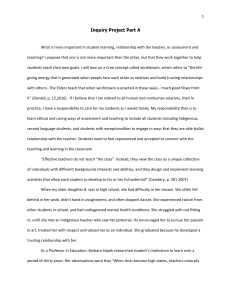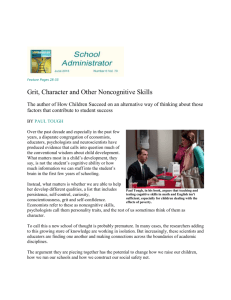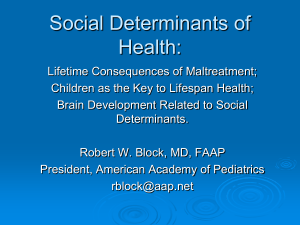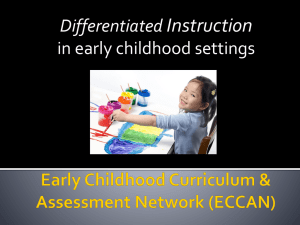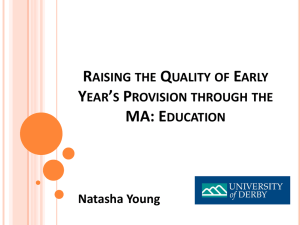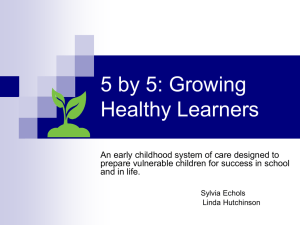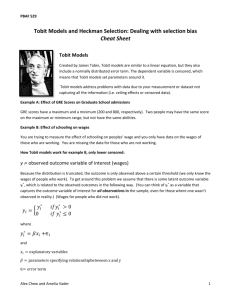EarlyChildhoodEd Poster
advertisement
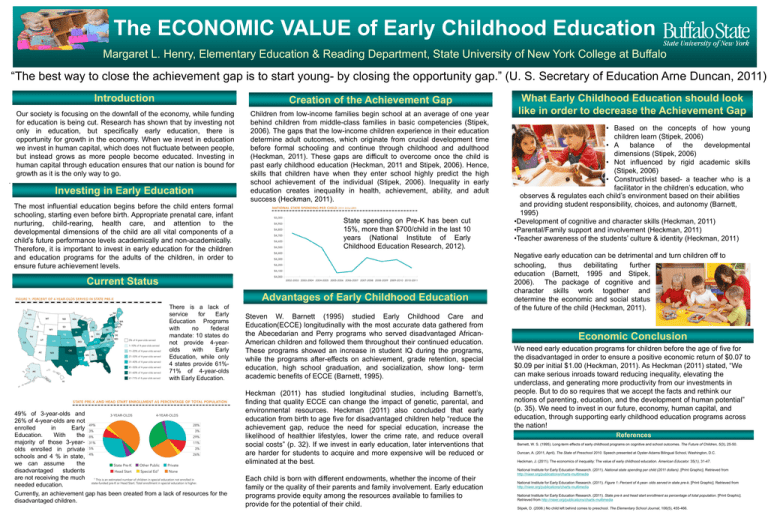
The ECONOMIC VALUE of Early Childhood Education Margaret L. Henry, Elementary Education & Reading Department, State University of New York College at Buffalo “The best way to close the achievement gap is to start young- by closing the opportunity gap.” (U. S. Secretary of Education Arne Duncan, 2011) Introduction Creation of the Achievement Gap Our society is focusing on the downfall of the economy, while funding for education is being cut. Research has shown that by investing not only in education, but specifically early education, there is opportunity for growth in the economy. When we invest in education we invest in human capital, which does not fluctuate between people, but instead grows as more people become educated. Investing in human capital through education ensures that our nation is bound for growth as it is the only way to go. Children from low-income families begin school at an average of one year behind children from middle-class families in basic competencies (Stipek, 2006). The gaps that the low-income children experience in their education determine adult outcomes, which originate from crucial development time before formal schooling and continue through childhood and adulthood (Heckman, 2011). These gaps are difficult to overcome once the child is past early childhood education (Heckman, 2011 and Stipek, 2006). Hence, skills that children have when they enter school highly predict the high school achievement of the individual (Stipek, 2006). Inequality in early education creates inequality in health, achievement, ability, and adult success (Heckman, 2011). . Investing in Early Education The most influential education begins before the child enters formal schooling, starting even before birth. Appropriate prenatal care, infant nurturing, child-rearing, health care, and attention to the developmental dimensions of the child are all vital components of a child’s future performance levels academically and non-academically. Therefore, it is important to invest in early education for the children and education programs for the adults of the children, in order to ensure future achievement levels. State spending on Pre-K has been cut 15%, more than $700/child in the last 10 years (National Institute of Early Childhood Education Research, 2012). Current Status Advantages of Early Childhood Education There is a lack of service for Early Education Programs with no federal mandate: 10 states do not provide 4-yearolds with Early Education, while only 4 states provide 61%71% of 4-year-olds with Early Education. 49% of 3-year-olds and 26% of 4-year-olds are not enrolled in Early Education. With the majority of those 3-yearolds enrolled in private schools and 4 % in state, we can assume the disadvantaged students are not receiving the much needed education. Currently, an achievement gap has been created from a lack of resources for the disadvantaged children. Steven W. Barnett (1995) studied Early Childhood Care and Education(ECCE) longitudinally with the most accurate data gathered from the Abecedarian and Perry programs who served disadvantaged AfricanAmerican children and followed them throughout their continued education. These programs showed an increase in student IQ during the programs, while the programs after-effects on achievement, grade retention, special education, high school graduation, and socialization, show long- term academic benefits of ECCE (Barnett, 1995). Heckman (2011) has studied longitudinal studies, including Barnett’s, finding that quality ECCE can change the impact of genetic, parental, and environmental resources. Heckman (2011) also concluded that early education from birth to age five for disadvantaged children help “reduce the achievement gap, reduce the need for special education, increase the likelihood of healthier lifestyles, lower the crime rate, and reduce overall social costs” (p. 32). If we invest in early education, later interventions that are harder for students to acquire and more expensive will be reduced or eliminated at the best. Each child is born with different endowments, whether the income of their family or the quality of their parents and family involvement. Early education programs provide equity among the resources available to families to provide for the potential of their child. What Early Childhood Education should look like in order to decrease the Achievement Gap • Based on the concepts of how young children learn (Stipek, 2006) • A balance of the developmental dimensions (Stipek, 2006) • Not influenced by rigid academic skills (Stipek, 2006) • Constructivist based- a teacher who is a facilitator in the children’s education, who observes & regulates each child’s environment based on their abilities and providing student responsibility, choices, and autonomy (Barnett, 1995) •Development of cognitive and character skills (Heckman, 2011) •Parental/Family support and involvement (Heckman, 2011) •Teacher awareness of the students’ culture & identity (Heckman, 2011) Negative early education can be detrimental and turn children off to schooling, thus debilitating further education (Barnett, 1995 and Stipek, 2006). The package of cognitive and character skills work together and determine the economic and social status of the future of the child (Heckman, 2011). Economic Conclusion We need early education programs for children before the age of five for the disadvantaged in order to ensure a positive economic return of $0.07 to $0.09 per initial $1.00 (Heckman, 2011). As Heckman (2011) stated, “We can make serious inroads toward reducing inequality, elevating the underclass, and generating more productivity from our investments in people. But to do so requires that we accept the facts and rethink our notions of parenting, education, and the development of human potential” (p. 35). We need to invest in our future, economy, human capital, and education, through supporting early childhood education programs across the nation! References Barnett, W. S. (1995). Long-term effects of early childhood programs on cognitive and school outcomes. The Future of Children, 5(3), 25-50. Duncan, A. (2011, April). The State of Preschool 2010. Speech presented at Oyster-Adams Bilingual School, Washington, D.C. Heckman, J. (2011). The economics of inequality: The value of early childhood education. American Educator. 35(1), 31-47. National Institute for Early Education Research. (2011). National state spending per child (2011 dollars). [Print Graphic]. Retrieved from http://nieer.org/publications/charts-multimedia National Institute for Early Education Research. (2011). Figure 1: Percent of 4-year- olds served in state pre-k. [Print Graphic]. Retrieved from http://nieer.org/publications/charts-multimedia National Institute for Early Education Research. (2011). State pre-k and head start enrollment as percentage of total population. [Print Graphic]. Retrieved from http://nieer.org/publications/charts-multimedia Stipek, D. (2006.) No child left behind comes to preschool. The Elementary School Journal, 106(5), 455-466.


